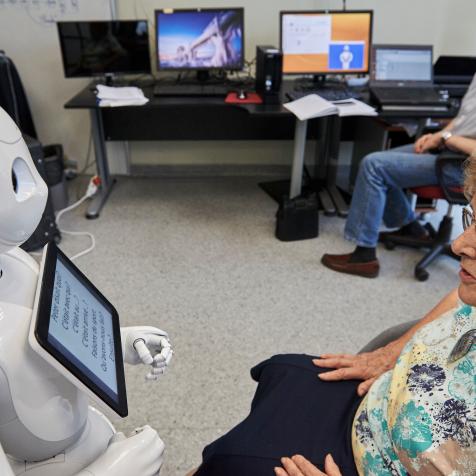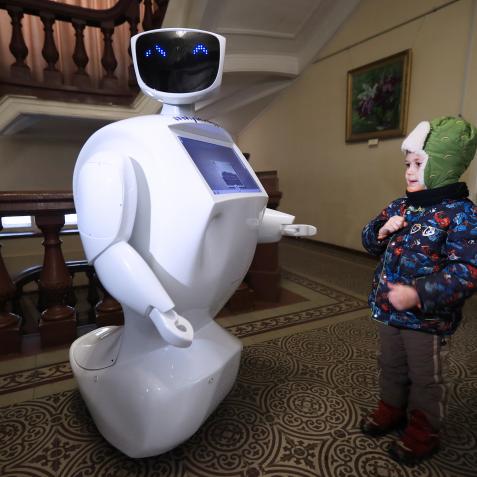
GettyImages/VCG
Wearable Technology
“To know thyself is the beginning of wisdom” is a saying that could be tailor-made for wearable technology. Attributed to Socrates, it's hard to guess what the ancient Greeks would make of fitness trackers, smart patches, and embedded biosensors, but the promise of next-generation wearables is enough to intrigue even the most jaded philosopher.
Photos
See All PhotosToday's smart clothing and accessories offer access to a vast array of personal data. For athletes, there are smart shirts that can measure heart rate, respiration, stress or anaerobic fitness levels, as well as yoga pants that pulse to tell you when and where to move or hold a position. Jackets and smartwatches can connect you to music playlists, map directions, or your business schedule. There are even smart socks with microsensors to let diabetic wearers know if their feet are prone to injury.
The variety of interfaces is genuinely imaginative—especially when it comes to wearables that benefit your health. Diabetics can monitor blood sugar levels with an innovative tattoo, created by researchers at MIT and Harvard, that uses color-changing biosensitive inks. Permanent tattoos may be more than most people need, so DuoSkin offers an alternative – a design-your-own, sensory metallic tattoo that can connect to a smartphone, display body temperature or mood, and exchange data using near-field communication (NFC). Alternatively, smart contact lenses can provide life-changing glucose monitoring to diabetics in danger of developing glaucoma and blindness.
Researchers have new fabrics in development that include a textile laced with graphene for flexible electronics and wearable computing. It stores energy like a battery and can be used in healthcare monitoring. Another graphene-based wearable takes inspiration from octopus suckers to stay attached to the skin in wet or dry conditions. It contains a biosensor that reads ECG and pulse rate as well as speech patterns.
In the near future, we can expect high concept wearables like the currently-in-research Amazon-patented technology to read emotions and the AlterEgo neural interface that lets people talk without speaking. AlterEgo allows users to articulate words internally, translating them into natural language to communicate with AI voice assistants and other services. MIT professor Pattie Maes says AlterEgo promises to be an experience in tune with our most personal thoughts. “Systems that have an awareness of the user — their [mental and emotional] state, their intentions — will ultimately be less intrusive and more useful.”
So far so space-age—yet, the introduction of the sci-fi inspired Google Glass in 2013 failed to impress tech consumers. Wearers distracted by its notifications and augmented reality display reportedly walked into traffic. Privacy and surveillance concerns arose from users potentially video-recording people without consent. However, Glass may be back – the Enterprise Edition 2 is ready for sale – but it’s pivoted its target to strictly business users.
Less obtrusive technology appears to be more acceptable and 'hearables' are the current buzz in consumer wearables. Apple's Airpods connected to its voice assistant Siri are just one of many smart ear-wear brands out there. Others include wireless headphones and hearing aids that now include biometric, proximity, or movement sensors. They can detect activity, stress, or even falls. When traveling abroad, smart earphones such as Waverley Labs' 'Ambassador' can provide in-ear, real-time language translation.
Noise-canceling features can even focus the listener on one sound or a single voice. They are AI-connected helpers for our ears, says Dolby Laboratories chief scientist Poppy Crum. “The ear is like a biological equivalent of a USB port,” she says. “It is unparalleled not only as a point for 'writing' to the brain, as happens when our earbuds transmit the sounds of our favorite music, but also for 'reading' from the brain.”
But the brave new frontier for wearables appears to be the embeddable or implantable market. That frontier has been opened up to medicine through cardiac pacemakers and contraceptive devices and will continue to expand.
Medics at Stanford have created an implantable cardioverter-defibrillator to wirelessly regulate heartbeat for patients whose hearts beat dangerously fast. Researchers at the Wyss Institute have designed an implantable cancer vaccine sponge that sits under the skin and recruits the body's natural immunity to find and kill cancer cells. These embeddables are highly targeted smart devices that will revolutionize healthcare.
For biomonitoring and drug delivery, we now have a class of smart pills (or ingestibles) that can tell us whether patients have taken their medication, measure their internal temperature, and diagnose gut health, using bacteria or the genetic technology CRISPR.
Getting images of the intestines or gut is currently an uncomfortable invasive procedure using endoscopes. By installing a camera into a smart pill, we could capture pictures or video without the pain of a colonoscopy. Another way is to use ultrasound, as Stanford's Arabian Lab suggests, to wirelessly transmit images of the intestines and surrounding organs. Medics can then assess the images for traces of cancer and other diseases.
For more delicate body systems such as the brain, the danger of invasive procedures is more acute. Yet scientists are innovating deep brain stimulation techniques, using probes inserted into different areas of the brain, to treat depression, OCD, and complicated brain disorders such as Parkinson's disease and epilepsy. Even here wearable technologies are making an impact. Non-invasive brain-computer interfaces can provide transcranial therapies to modulate brain function in patients with rare movement disorders.
Research into transcranial direct current stimulation (tCDS) is ongoing but commercial company CTRL-Labs sees the highly sensitive movement signals the brain gives to our bodies as the way forward. It has developed a wristband that combines neuroscience and machine learning to translate brain signals to the hand into a computer input. Wearers can control a computer and play games without physically touching a mouse or joystick.
More futuristic wearables can be found in the field of defense – brain stimulation kits that improve a drone pilot's performance or allow a soldier to control a bomb disposal robot. While ambitious plans to link up our brains direct to computers (with a neural lace mesh implanted in the skull) have been touted by both Neuralink and Kernel.
The dangers in connecting our bodies up to computers and wider networks are not to be taken lightly. Should we allow any organization to 'read' our thoughts or collect intimate data on brain activity? Outside of physical or mental injury, the possibility for data breaches or misuse of personal information is obvious.
In the race to know ourselves and improve our performance through technology, we need to think clearly about what we want. Wearable technology should ultimately offer us greater self-knowledge and control, not make us more vulnerable.





















